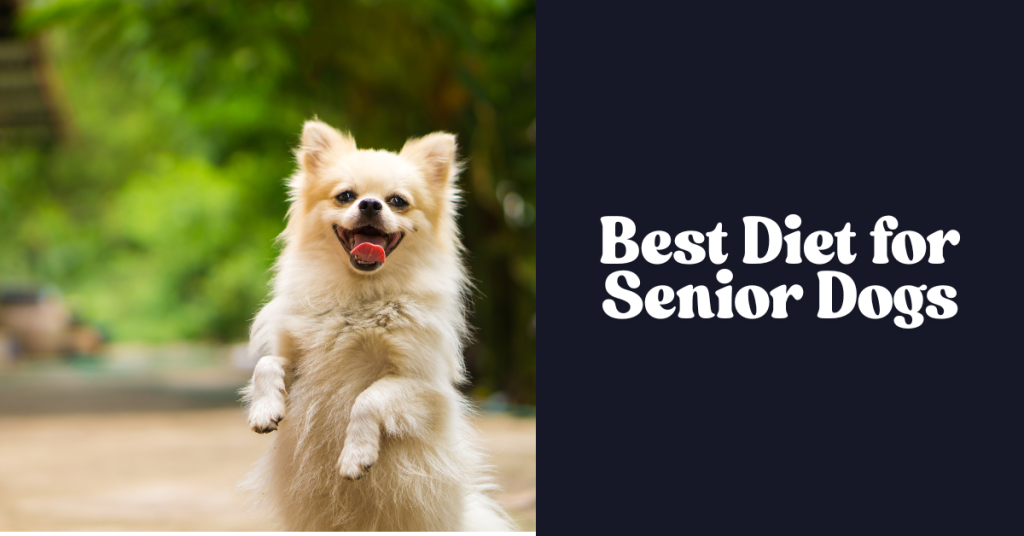The best diet for senior dogs is high in lean protein, moderate in fat, and rich in fiber to support digestion. Older dogs benefit from added omega-3s for joint health, antioxidants for immunity, and controlled calories to prevent weight gain. Always adjust portions based on age, activity level, and existing health conditions.
What Changes In A Senior Dog’s Body (And Why Diet Must Follow)
Aging subtly shifts a dog’s metabolism, body composition, and organ resilience. Most seniors experience decreased lean muscle, slower digestion, and higher risk of chronic conditions like arthritis, kidney disease, heart disease, dental issues, and cognitive decline.
Calorie needs may drop, but protein needs often stay the same—or increase—to preserve muscle. Many also benefit from anti-inflammatory omega-3s, higher-fiber foods for gut health, and careful sodium, phosphorus, and fat tuning when conditions arise.
From my own experience helping a 12-year-old Lab named Daisy, simply switching to an AAFCO-compliant senior formula with elevated protein and omega-3s noticeably improved her energy and mobility within six weeks—proof that small, targeted changes can have outsized impact.
Core Nutrients Senior Dogs Really Need
High-quality protein: Look for named animal proteins (chicken, turkey, fish, beef). Adequate protein supports muscle mass and immune function. Many seniors thrive at similar or slightly higher protein than in adulthood—assuming no advanced kidney disease.
Healthy fats and omega-3s (EPA/DHA): Support joint comfort, brain health, and skin. Fish oil is the gold standard; algae oil is a solid plant-based alternative.
Digestible carbohydrates and fiber: Oatmeal, barley, sweet potato, and beet pulp can stabilize energy and support the microbiome. Prebiotics (FOS, inulin) and probiotics add gut resilience.
Micronutrients: Vitamin E, B vitamins, taurine (for some breeds/foods), and antioxidants (lutein, carotenoids) help combat oxidative stress.
Joint support: Glucosamine, chondroitin, green-lipped mussel, and curcumin may reduce stiffness in some dogs.
Key Takeaway: choosing foods with proven digestibility, omega-3 enrichment, and evidence-backed supplements can meaningfully improve quality of life.
How To Choose The Right Senior Dog Food
Check for AAFCO adequacy: Look for “complete and balanced” for adult maintenance or all life stages.
Prefer brands that follow WSAVA-aligned practices: In-house vets/nutritionists, feeding trials, published research.
Read the ingredient panel: Named proteins, no vague “meat by-product” without source, and a sensible fat source.
Assess guaranteed analysis: Adequate protein, appropriate fat, and fiber that suits your dog’s stool quality.
Call the company: Ask about digestibility trials, omega-3 levels, and quality control testing.
Pro tip: companies willing to share batch testing, digestibility data, and target nutrient ranges tend to be more trustworthy.
Protein, Fat, And Carbs
There’s no universal magic ratio, but a practical starting framework for healthy seniors is:
Protein: Often 24–32% on a dry matter basis (DMB), adjusted for activity and medical status.
Fat: Typically 10–18% DMB; lower for pancreatitis-prone dogs, higher for underweight seniors.
Fiber: 3–7% DMB for most; increase for overweight dogs or those with anal gland issues.
Omega-3s: Aim for a meaningful EPA/DHA level (often 0.3–1% DMB combined in many senior formulas).
Always tailor with your veterinarian if your dog has kidney, liver, or heart disease, as these conditions can require precise adjustments.
Special Diets For Common Senior Conditions
Arthritis and mobility: Prioritize EPA/DHA, green-lipped mussel, and lean body weight. Consider fortified senior diets or therapeutic joint formulas.
Kidney disease (CKD): Often requires controlled phosphorus and, at moderate to advanced stages, adjusted protein. Hydration and palatability are crucial.
Heart disease: Watch sodium; ensure adequate taurine and carnitine when advised. Maintain an ideal body condition to reduce cardiac load.
Cognitive decline (CDS): Diets enriched with MCTs, antioxidants, B vitamins, and omega-3s support brain health.
Pancreatitis history: Use low-fat, easily digestible diets; avoid table scraps and high-fat treats.
Diabetes: Consistent feeding times, moderate fiber, and controlled carbs; coordinate closely with insulin routines.
I once managed a senior Beagle with early CKD; shifting to a veterinary therapeutic kidney diet, adding fish oil, and warming wet food to boost aroma kept her eating consistently and improved lab values over months. Monitoring urine protein, creatinine, SDMA, and blood pressure guided safe tweaks.
Supplements That Actually Help (And When To Skip)
Fish oil (EPA/DHA): Evidence-backed for joints, skin, and cognition. Dose per vet guidance to avoid GI upset.
Glucosamine/chondroitin/green-lipped mussel: May reduce stiffness; effects are gradual (4–8 weeks).
Probiotics: Support stool quality and immune function; choose products with strain and CFU disclosure.
MCT oil: Can support cognitive function; start low to avoid loose stools.
Turmeric/curcumin: Potential anti-inflammatory; use standardized products with vet oversight.
Be cautious with multis that duplicate nutrients already in food, and avoid unregulated, high-dose herbs without professional input. Quality and dosing matter more than lengthy ingredient lists.
Wet Vs. Dry Vs. Fresh Vs. Homemade
Dry (kibble): Convenient, often more affordable, can be dental-friendly when paired with dental chews. Ensure fresh water and consider toppers for aroma.
Wet/canned: Higher moisture for hydration and kidney support; generally more palatable—great for picky eaters or dental issues.
Fresh/frozen or gently cooked: Highly palatable and digestible; verify complete and balanced formulations.
Homemade: Only with a board-certified veterinary nutritionist recipe; otherwise nutrient gaps are common.
What worked for my picky senior Collie mix: a base of lower-fat kibble, topped with warm, fish-rich wet food and hydrated with bone broth (vet-approved, low sodium). Appetite and joint comfort improved without weight gain.
Portion Sizes, Feeding Schedule, And Weight Management
Calculate calories: Start with feeding guide on the bag, then adjust every 2–3 weeks based on body condition.
Body Condition Score (BCS): Aim for a visible waist and easy-to-feel ribs with a thin fat cover (4–5/9).
Meal frequency: Split daily calories into 2–3 meals to ease digestion and stabilize energy.
Treats: Keep to ≤10% of daily calories; use crunchy veggies, freeze-dried lean meats, or your dog’s kibble.
For overweight seniors, create a 10–20% calorie deficit, bump up fiber and activity, and recheck weight every two weeks. Small, consistent changes beat crash diets.
How To Transition Your Senior Dog’s Diet Safely
– Days 1–2: 75% old food, 25% new
– Days 3–4: 50% old, 50% new
– Days 5–6: 25% old, 75% new
– Day 7+: 100% new
Slow down if you see soft stools, gas, or itching. Add a probiotic during the transition and keep hydration high.
Sample 7-Day Senior-Friendly Meal Framework
Use this as inspiration and tailor with your vet:
– Base: Complete and balanced senior or all-life-stages food with higher-quality protein.
– Toppers (rotate small amounts): Sardines in water, pumpkin puree, kefir or plain yogurt, steamed green beans, turmeric paste (vet-approved), bone broth (low sodium).
– Supplements: Fish oil and joint support if indicated.
– Hydration: Fresh water and consider a water fountain to encourage drinking.
Keep toppers within 10% of daily calories to avoid unbalancing the diet.
How To Tell The Diet Is Working
– Steady energy and willingness to walk or play
– Glossy coat, healthy skin, and minimal shedding outside seasonal norms
– Consistent, well-formed stools and less gas
– Stable or improving **BCS** and preserved muscle over the back and thighs
– Eased morning stiffness and smoother transitions from lying to standing
– Normal lab work for your dog’s condition and age trends
If you notice vomiting, diarrhea, new itchiness, rapid weight changes, or lethargy, check in with your vet and reassess the plan.
Budgeting And Smart Shopping Checklist
– Choose AAFCO complete and balanced foods from companies with transparent research and quality control.
– Compare cost per 100 kcal, not just cost per bag.
– Buy bag sizes your dog can finish within 4–6 weeks to keep fats fresh.
– Store kibble in its original bag, sealed inside an airtight container.
– Prioritize spending on proven omega-3s and joint support before fancy, unproven add-ons.
A realistic strategy: use a reputable, mid-range kibble and elevate it with targeted fish oil and wet toppers, rather than paying premium for marketing alone.
FAQ’s
How Much Protein Should A Senior Dog Eat?
Most healthy seniors do well with 24–32% protein (DMB) from high-quality animal sources. Dogs with advanced kidney disease may need tailored protein and phosphorus levels—work with your vet.
Is Grain-Free Better For Senior Dogs?
Not inherently. Many seniors do well with wholesome grains like oats and barley. Choose grain-free only for verified sensitivities and ensure the diet meets AAFCO standards and has sound nutritional research behind it.
Do Senior Dogs Need Fewer Calories?
Often yes, due to lower activity, but not always. Track body condition and muscle mass; adjust calories up or down every few weeks rather than assuming a blanket reduction.
Should I Switch To Wet Food For My Senior Dog?
Wet food can boost hydration and palatability, especially for dogs with dental issues or kidney concerns. Many owners use a mixed feeding approach: kibble for convenience, wet for moisture and aroma.
Which Supplements Are Worth It?
Evidence supports fish oil (EPA/DHA), some joint supplements, and probiotics. Skip overlap with nutrients already in the food, and confirm doses with your veterinarian.
How Fast Should I Transition To A New Food?
Over 7 days. Slow down if you see GI upset, and consider adding a probiotic during the change.
Conclusion
A great senior diet protects muscle with quality protein, calms inflammation with omega-3s, supports digestion with fiber and probiotics, and adapts to your dog’s unique health profile. Start with an AAFCO-compliant, research-driven food, personalize with targeted supplements, and monitor body condition and energy like a coach. Small, thoughtful adjustments—made consistently—deliver the biggest returns for comfort and longevity.
Take the next step today: review your senior dog’s bowl, pick one improvement to implement this week, and schedule a quick nutrition check-in with your vet. If you found this helpful, subscribe for more practical pet nutrition guides or drop a comment with your dog’s age and current diet—I’m happy to help you fine-tune.
I’ve loved dogs all my life and have cared for many different breeds over the years. Here, I share simple tips, stories, and helpful advice for all dog lovers. Whether you’re a new pet parent or a lifelong dog fan, you’ll find something useful and fun on my site.


